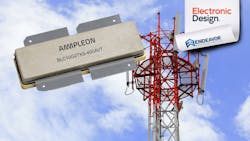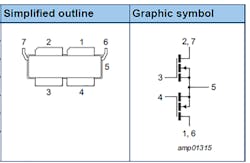2.5-GHz Amp Implements 400-W Asymmetric Doherty Architecture
This article appeared in Electronic Design and has been published here with permission.
The Doherty amplifier—a modified Class B topology—has been in use for many years. It was developed by William H. Doherty of the renowned Bell Telephone Laboratories in 1936 to accommodate signals with high peak-to-average power ratios. It used two amplifier circuits in an asymmetric arrangement, with a lower-power carrier amplifier and higher-power peaking amplifier within the overall amplifier (Fig. 1). (Note: this “Class B” is unrelated to another popular “Class B” rating for conducted and radiated EMC requirements of EN55022-B and FCC Class B standards.)
Unlike standard Class B amplifiers that can “clip” more than is acceptable at high input-signal levels, the Doherty amplifier achieves a high level of linearity while retaining good power efficiency. It’s been used in implementations from low power to some as high as 50,000 W. In recent decades, interest has increased in the Doherty approach for base stations and other situations where its ability to balance the conflicting requirements and tradeoffs for linearity and efficiency is a major benefit.
To encourage use of this approach in the lower gigahertz region, Ampleon introduced the BLC10G27XS-400AVT, a 400-W asymmetric Doherty RF power transistor targeting base-station multi-carrier applications from 2.496 to 2.690 GHz. The LDMOS device provides power gain of 13.3 dB with typical drain efficiency of 45%. This electrically rugged power amplifier handles VSWR mismatches as high as 10:1, an important factor for base-station applications that often experience extreme-mismatch conditions.
This power amp (PA) also features integrated ESD protection, has a low output capacitance for improved Doherty performance, and includes internal input and output impedance transformation, thus enabling easier PCB matching to 50-Ω interfaces. It’s housed in a six-lead, air-cavity plastic (ACP), “earless” SOT-1258-4 package that offers low thermal resistance for enhanced excellent thermal stability (Fig. 2).
Of course, every PA needs a driver, and Ampleon offers the BLM9D2327S-50PB MMIC, itself a Doherty-topology device. The 15-page BLC10G27XS-400AVT datasheet includes the PCB layout for a test circuit with call-out of the special PCB material and full bill of materials. Further vendor support includes simulation models, application notes, and white papers such as the 14-page “Doherty Architectures in UHF.”
There’s even an RF power transistor lifetime calculator that allows designers to enter data about operating conditions and returns an estimate of factors such as anticipated junction temperature and mean time to failure (MTTF).
About the Author

Bill Schweber
Contributing Editor
Bill Schweber is an electronics engineer who has written three textbooks on electronic communications systems, as well as hundreds of technical articles, opinion columns, and product features. In past roles, he worked as a technical website manager for multiple topic-specific sites for EE Times, as well as both the Executive Editor and Analog Editor at EDN.
At Analog Devices Inc., Bill was in marketing communications (public relations). As a result, he has been on both sides of the technical PR function, presenting company products, stories, and messages to the media and also as the recipient of these.
Prior to the MarCom role at Analog, Bill was associate editor of their respected technical journal and worked in their product marketing and applications engineering groups. Before those roles, he was at Instron Corp., doing hands-on analog- and power-circuit design and systems integration for materials-testing machine controls.
Bill has an MSEE (Univ. of Mass) and BSEE (Columbia Univ.), is a Registered Professional Engineer, and holds an Advanced Class amateur radio license. He has also planned, written, and presented online courses on a variety of engineering topics, including MOSFET basics, ADC selection, and driving LEDs.


